7 Historical Sites in Nara Every History Buff Should Visit
As a history enthusiast, you should consider visiting Nara, a cradle of Japanese heritage. Explore Todai-ji Temple, a landmark of Japanese architecture with its monumental Buddha statue. Don't miss Kasuga Taisha, revered for its bi-annual lantern festivals that illuminate ancient spiritual practices. Wander through Naramachi district, where traditional merchant houses reveal insights into Nara's Edo-period life. Investigate the architectural remnants at Heijo Palace Ruins, reflecting the administrative acumen of early Japan. At Kofuku-ji, the towering pagoda symbolically portrays architectural evolution. Finally, Toshodai-ji and Gangoji Temple offer unique perspectives on Tang influence and cultural syntheses in religious architecture. Each site encapsulates a crucial chapter in Nara's historical narrative, inviting further exploration into its storied past.
Todai-ji Temple Overview
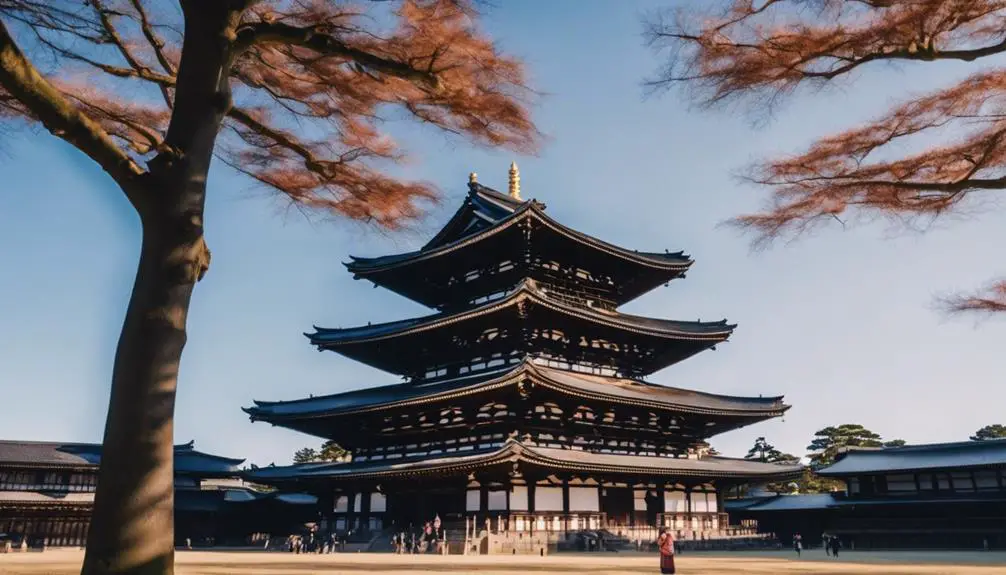
Todai-ji Temple, a UNESCO World Heritage site, epitomizes the cultural and historical essence of Nara with its monumental structures and sacred artifacts. As you explore further, you'll discover that the Great Buddha Hall, known as Daibutsuden, stands as the world's largest wooden building, housing a 500-ton statue of the Buddha. This colossal figure, crafted from 437 tons of bronze and 130 kilograms of gold, represents a significant feat in both religious artistry and ancient engineering.
The architectural grandeur of Todai-ji extends beyond the Daibutsuden. The Nandai Gate, an imposing wooden gateway, serves as a critical threshold, ushering visitors into a space where spirituality and history converge seamlessly. This gate, adorned with intricate carvings, exemplifies the zenith of Japanese temple architecture and underscores the site's status as a pivotal historical landmark.
The essence of Todai-ji Temple as a cornerstone of Buddhist devotion and Japanese culture is palpable. Each structure within the temple grounds narrates a part of Nara's rich historical tapestry, making it not just a site of religious significance but a beacon of cultural heritage that continues to draw scholars and enthusiasts alike.
Exploring Kasuga Taisha
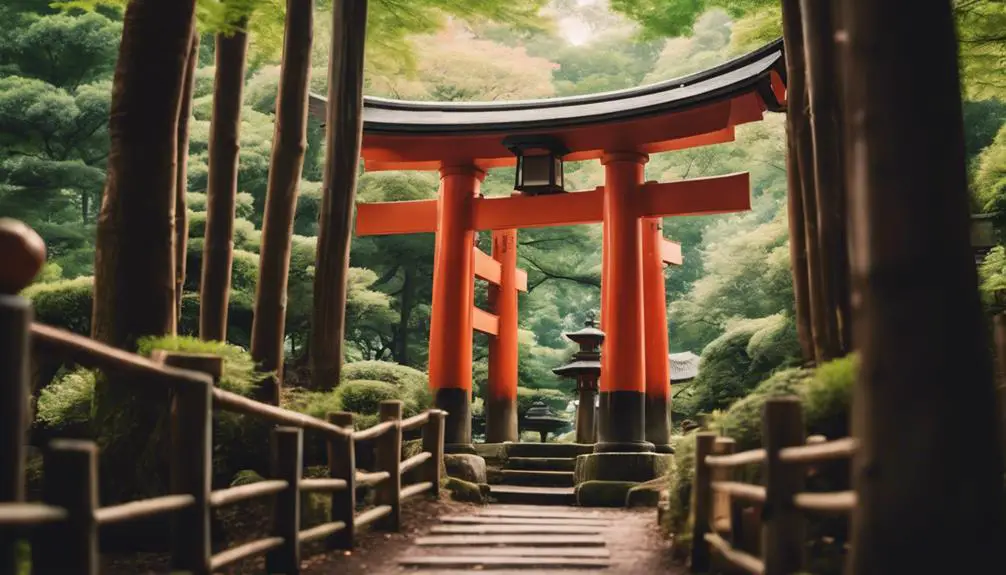
Continuing your journey through Nara's rich cultural landscape, you'll encounter Kasuga Taisha, a Shinto shrine distinguished by its mesmerizing array of 3,000 lanterns. Established in the 8th century, this shrine is not only a spiritual center but also a historical beacon, dedicated to the deity charged with protecting the city.
As you explore, you'll notice the striking vermilion buildings that contrast vividly against the lush greenery of the surrounding forest—a deliberate design to signify the sacred boundary between the spiritual and earthly domains. Kasuga Taisha's architecture and its harmonious relationship with nature exemplify classical Shinto aesthetics, making it a profound study in religious architectural evolution.
The lanterns, which you'll see lining the pathways and adorning the buildings, are lit during the bi-annual lantern festivals, creating an ethereal atmosphere that transforms the shrine into a domain of light and shadow. These festivals not only illuminate the shrine but also symbolize the illumination of the soul, reflecting the shrine's ongoing role in community spiritual life.
Here's a table to summarize key aspects of Kasuga Taisha:
| Feature | Detail | Significance |
|---|---|---|
| UNESCO Status | World Heritage Site since 1998 | Recognition of historical and cultural importance |
| Main Deity | Protector of Nara | Spiritual and historical guardianship |
| Lantern Festivals | Bi-annual events | Cultural and spiritual rejuvenation |
Kasuga Taisha Shrine remains a cornerstone of Nara's historical and spiritual identity, inviting you to explore further into its storied past.
Naramachi District Walkthrough
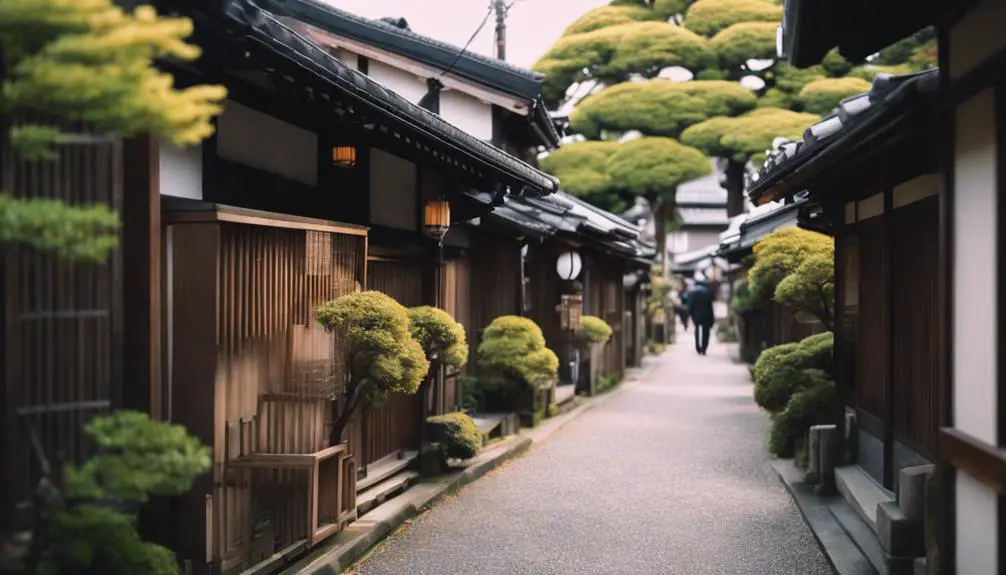
Explore Naramachi District, where the intricately preserved machiya houses and winding streets offer an authentic glimpse into Nara's Edo period heritage. As you wander through this historical enclave, note the traditional merchant houses that line the narrow lanes. These structures, characterized by their wooden facades and lattice work, offer a palpable connection to the commercial vigor of the Edo era.
Among the key cultural attractions in Naramachi is the Naramachi Koshino Ie, a meticulously restored merchant home. Here, you can investigate the everyday life of a merchant family, observing the architectural nuances that facilitated both residential living and commercial activities under one roof. Similarly, the Naramachi Mechanical Toy Museum presents a fascinating juxtaposition of historical preservation and playful innovation, showcasing traditional mechanical toys that have delighted generations.
The district also offers a robust shopping experience. Engage with local artisans and explore shops specializing in local crafts, where you can acquire unique souvenirs and traditional snacks. Each purchase supports the preservation of Nara's cultural heritage, making your shopping both a leisurely and a socially responsible endeavor.
Naramachi isn't just a walk through history; it's an immersive journey into the cultural and economic tapestry that shaped modern Nara.
Heijo Palace Ruins
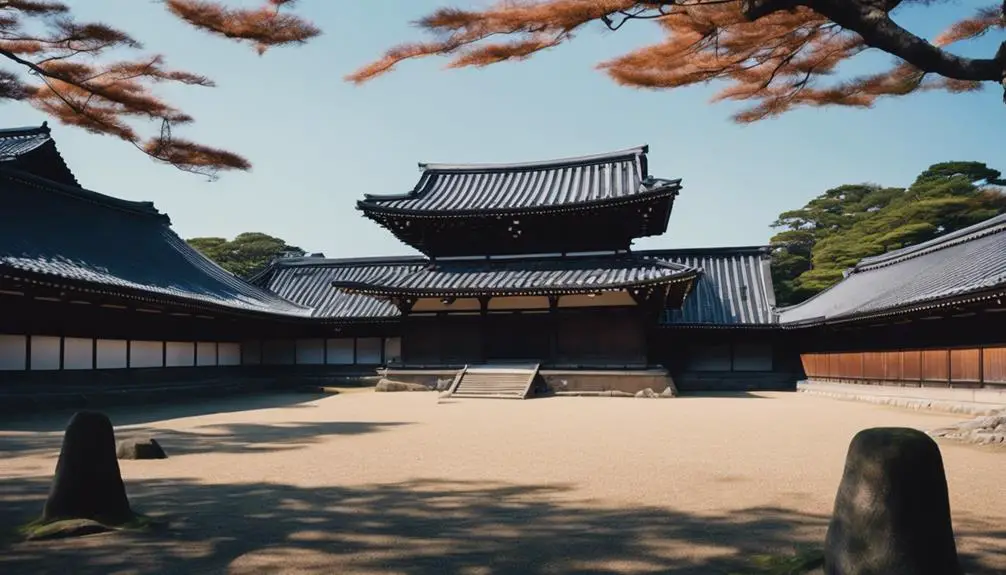
As you explore the Heijo Palace Ruins, you're stepping onto the grounds of what was once the heart of Japan's imperial and administrative activities from 710 to 784. This site, now a UNESCO World Heritage Site, functioned as both the imperial residence and the ceremonial center of the early Japanese state, encapsulating the grandeur of Japan's ancient capital, Nara.
The expansive layout of Heijo Palace, covering an area of 1300 meters by 1200 meters, reveals the sophisticated urban planning of ancient Japan. The architectural features preserved in the ruins provide a window into the aesthetic and structural preferences of the era, highlighting the blend of functionality and formality that characterized imperial designs.
Here are key aspects to focus on during your visit:
- The scale of the palace complex: Reflects the administrative prowess and the centralized governance of the time.
- Architectural remnants: Offer insights into the construction techniques and materials used in the Nara period.
- Spatial organization: Illustrates the hierarchical nature of the early Japanese state.
- Designated UNESCO status: Emphasizes the global importance of Heijo Palace Ruins among other Nara monuments.
Each element of the ruins enriches your understanding of Japan's rich historical tapestry.
Kofuku-ji Temple Architecture
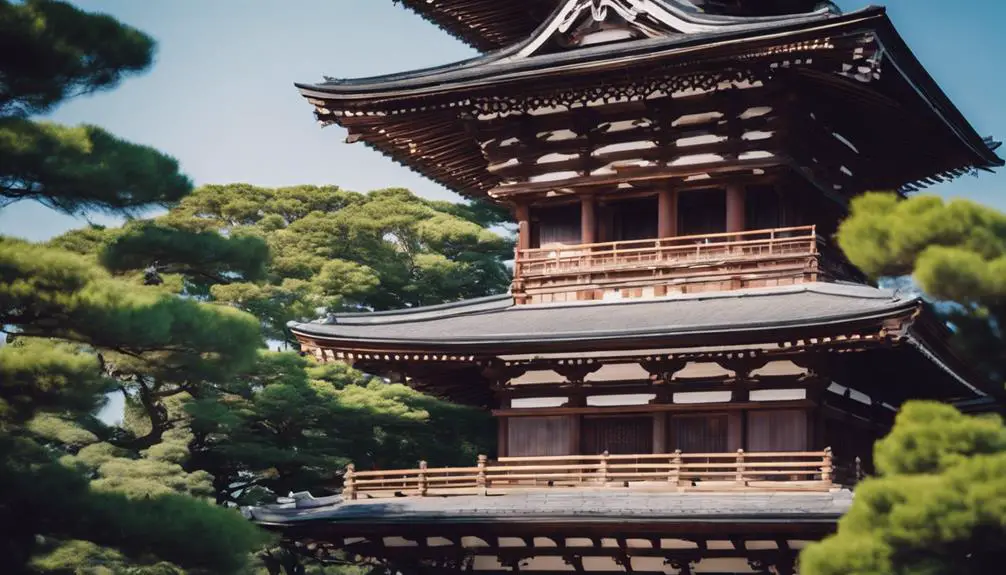
Kofuku-ji Temple, a UNESCO World World Heritage Site, stands as a demonstration of the architectural sophistication and religious significance of Nara's cultural heritage. As you explore the details of this historic monument, you'll recognize it as a pivotal example of Japanese temple architecture, seamlessly blending function with aesthetic grace.
The temple's most iconic feature, the five-story pagoda, reaches skyward, embodying the aspirations and artistic achievements of ancient Japanese culture. This pagoda not only serves as a symbol of Nara but also highlights the architectural beauty that Kofuku-ji Temple is renowned for.
Surrounding the pagoda, various halls, including the Central Golden Hall, house an array of national treasures and significant Buddhist relics, further cementing the temple's historical significance.
Each structure within the complex tells a story of the evolution of Japanese architecture, from the intricate wooden joinery to the harmonious alignment with the natural landscape. The ongoing renovations you observe today are a confirmation of the enduring importance placed on preserving such a unique architectural heritage.
In exploring Kofuku-ji Temple, you're not just walking through a physical space, but traversing through layers of history, each hall and artifact whispering tales of a rich, spiritual past.
Visit to Toshodai-ji
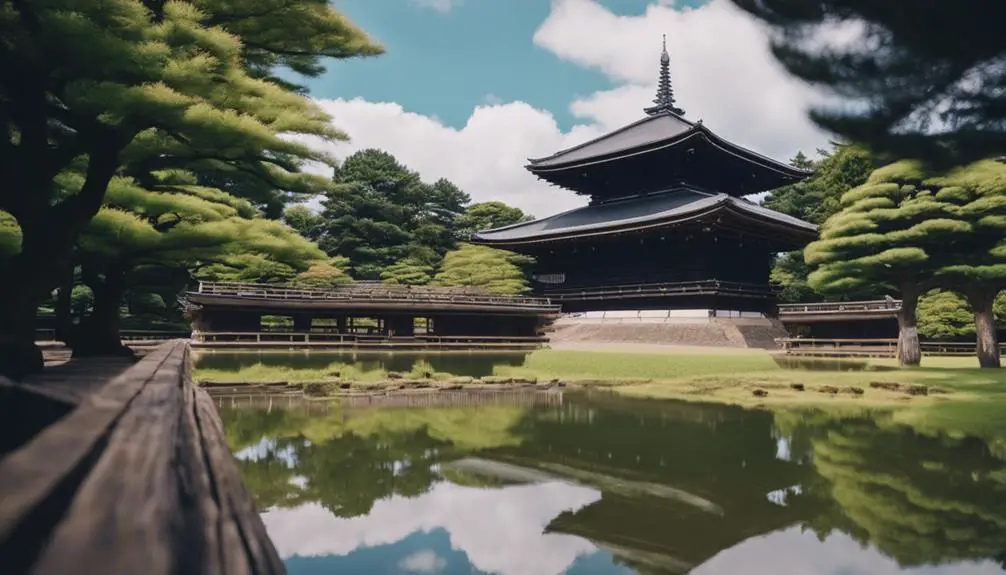
You'll find that a visit to Toshodai-ji offers a profound insight into the confluence of Chinese and Japanese architectural styles during the early Nara period. Founded in 759 by the Chinese monk Jianzhen, this Buddhist temple serves as a demonstration to the cultural and religious exchange between China and Japan. As a UNESCO World Heritage Site, Toshodai-ji's significance extends beyond its religious function, embodying the historical narrative of the era.
The temple's architecture, particularly the Kondo or Golden Hall, showcases the intricate Tang dynasty influences that pervade early Nara period architecture. The blending of sharp, angular Chinese lines with the subtler, more fluid Japanese aesthetic creates a unique visual harmony that captivates any observer.
Here are a few highlights:
- The Kondo (Golden Hall): Experience the majestic centerpiece of Toshodai-ji, reflecting the zenith of Tang architectural sophistication.
- Intricate Pagoda: Marvel at the pagoda, a symbol of Jianzhen's enduring legacy and architectural prowess.
- Buddhist Artifacts: Discover a collection of historically significant Buddhist statues and relics housed within the temple.
- UNESCO Status: Understand why Toshodai-ji's unique architectural and historical value earned it UNESCO World Heritage recognition.
This site not only enriches your understanding of Buddhist architectural evolution but also offers a reflective glimpse into the spiritual landscape of ancient Japan.
Gangoji Temple Insights
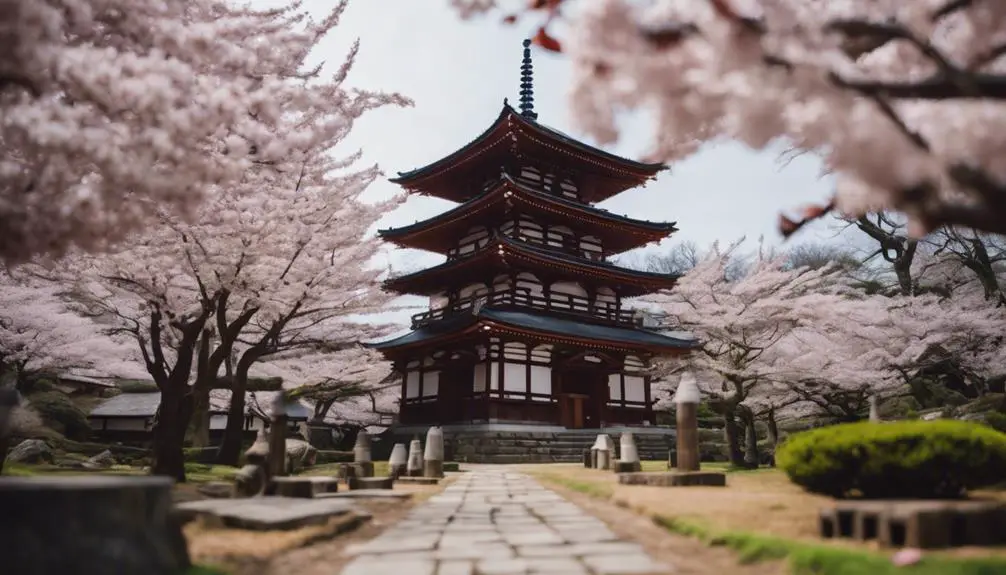
Explore Gangoji Temple, a cornerstone of Nara's religious heritage, where early Japanese Buddhist architecture melds with diverse Asian influences. As you walk through the temple grounds, you'll witness a unique blend of architectural styles that reflect the cultural confluence that characterizes the region. This UNESCO World Heritage Site not only showcases the aesthetic beauty of Buddhist architecture but also serves as a demonstration of the historical significance of the interactions between Chinese, Korean, and indigenous Japanese cultures.
The temple, one of the Seven Great Temples of Nara, was established in the 6th century and has since been a pivotal site for spiritual introspection and religious gatherings. The architectural elements you see here, from the intricate roof designs to the spatial arrangements, are influenced heavily by both Chinese and Korean artisans, who brought their craftsmanship and spiritual ideas to Japan. This amalgamation not only enriched Japanese cultural heritage but also contributed to the unique development of regional Buddhist practices.
As a history buff, you'll appreciate how Gangoji Temple encapsulates the synthesis of cultural influences that shaped early Japanese Buddhism. The temple not only offers a glimpse into the spiritual life of ancient Japan but also invites reflection on the dynamic exchange of ideas across borders.
